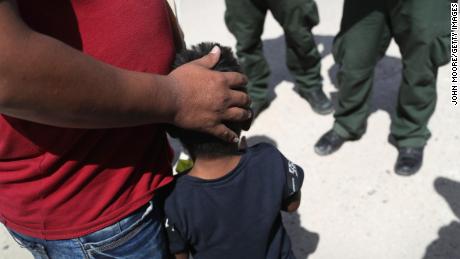Washington (CNN)One week.
That's how long the US Department of Health and Human Services has to reunite as many as 2,551 children ages five and up who were separated from their families after crossing the US border.
HHS staffers tackling the crisis are working around the clock in an operations center at the department's Washington headquarters to meet a July 26 court deadline for the reunification.
Reporters on Thursday were invited to tour the operations center and observe the arduous task of reuniting the families.
They got a peek at the center of the action, a place that usually comes alive for national disasters such as hurricanes and disease outbreaks.
"This is a novel process," explains HHS's Jonathan White, who works in the office of the department's assistant secretary for preparedness and response.
He spoke amid nonstop news coverage on TV screens in the operations center and rows of computers facing a front wall with numbers computer screens projected on to it.
Numbers like 11,987 -- the total number of unaccompanied children in HHS care as of Wednesday. It is a number that constantly changes. Roughly 80 percent of those children arrived unaccompanied and some of them were separated, he said.
The HHS team, he says, has worked for years to reunite children who arrive alone to the US with parents or suitable sponsors and the process can take an average of 50 days. And he has dealt with influxes of unaccompanied children coming into HHS care many times before.
But this time is different.
"The program is not built to reunify children with parents who are in detention," White said, echoing a common HHS talking point.
This team's biggest task has been to go through each of the nearly 12,000 case files of unaccompanied children in their care to see which of them were separated from their parents at the border.
HHS secretary Alex Azar has been leading the effort to meet the reunification. He personally sat in this operations center to help manually go through these case files, and the team spent more than 600 hours to complete their reviews in nearly a month of work.
An overwhelming task
Groups across the country working to help reunite families also know the government has a heavy lift.
"From the reports we are hearing, HHS is completely overwhelmed while trying to reunite the families they ripped apart," according to Jennifer Falcon, a spokeswoman with RAICES, an organization in Texas that works with immigrants and has focused on reuniting separated families.
"It was clear they didn't have any plan for reunification when they began separating families and now are chaotically scrambling to right the wrong they've made," Falcon said.
As of July 13, the government has said it has 2,551 children in its custody between the ages of 5 and 17 who were separated from parents at the border and could be eligible for reunification.
Some of those children were separated from their parents after May 5, when the Trump administration's zero tolerance policy went into effect, promising to prosecute anyone who enters the United States illegally. Some children were separated from parents for other reasons.
As of Wednesday night, 364 separated children had been reunited with their parents, according to court filings.
Adapt to changing circumstances
The team has turned to using DNA testing in some cases to confirm children are being reunited with their actual parents, which has mostly been done for children under the age of five, says Chris Meekins, chief of staff for the office of the assistant secretary for preparedness and response.
To HHS spokesman Mark Weber, this is a sign that HHS has, once again, managed to adapt to changing circumstances. He remembers influxes of unaccompanied children in 2012, 2014, 2016 and 2018. Each influx presented different challenges, Weber says.
"This program learned an invaluable lesson in 2014 because of the backup at the Border Patrol stations. I think it's an amazing turnaround story in terms of federal programs," Weber said.
Weber says that his team saw numbers of unaccompanied children in their custody going up starting last year, and opened more facilities in anticipation of a bigger increase.
"Usually, numbers increase because of migration patterns. This time they were increasing because of policy change," Weber said.
When reporters asked whether HHS had received a heads up that a new zero tolerance policy could impact their numbers of unaccompanied children, Weber said he didn't know.
"I just work with the program," he said.
Falcon maintained families are being held "in unsafe conditions and facilities throughout the US."
When asked by reporters about conditions in shelters where children have been taken, Weber replied, "If there is a problem at one of our shelters, we want to know about it and we want it fixed."
CORRECTION: This story has been updated to remove a quote that was incorrectly attributed to HHS official Jonathan White.







